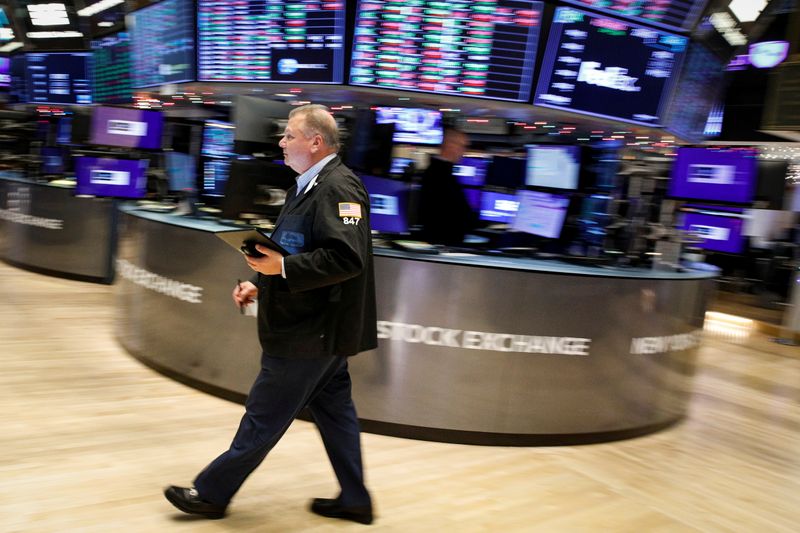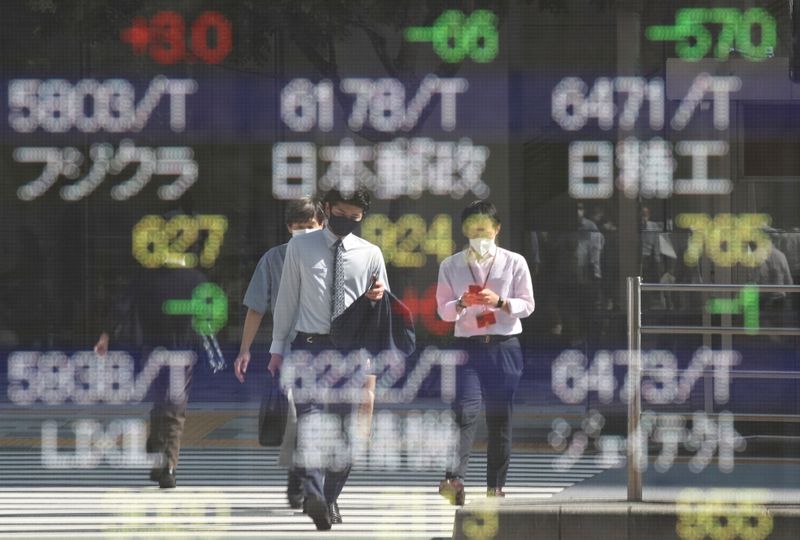By Herbert Lash and Marc Jones
NEW YORK/LONDON (Reuters) -Global equity markets and oil prices surged on Tuesday after a timely shot of Chinese stimulus helped spark a rally that was further fueled by views that the Omicron COVID-19 variant will not cause major economic damage.
The Nasdaq jumped 3% as technology shares bounced back, helping the FTSEurofirst 300 index of leading European companies post its first back-to-back run of more than 1% gains since February.
Tech stocks climbed 5.6% in Europe, while the S&P information technology sector rose 3.5%, driving almost half of the S&P 500's gains. Semiconductors advanced 5.0% and all 11 of the S&P sectors rose. Growth rose 2.7%, outpacing value's 1.3% gain.
Asia overnight cheered record bounces by some of China's beaten-down tech giants, including e-commerce giant Alibaba (NYSE:BABA) Group and other technology majors, including JD.com Inc and Baidu Inc (NASDAQ:BIDU).
Portfolio managers did not want to be left behind in an impressive rally, helping drive equities higher, said Michael James, managing director of equity trading at Wedbush Securities in Los Angeles.
"Did the seasonal Santa Claus rally, which we typically have at some point in December, start yesterday?" he said. "There's certainly fear of missing out."
An easing of Omicron fears also emboldened investors to have a little more of a "risk-on" mentality, James said.
Preliminary evidence indicates that Omicron likely has a higher degree of transmissibility but is less severe, top U.S. infectious disease expert Anthony Fauci said on Tuesday.
MSCI's all-country world index advanced 2.1% in its biggest percentage gain since November 2020. The FTSEurofirst 300 in Europe closed up 2.42%.
On Wall Street, the Dow Jones Industrial Average rose 1.40%, the S&P 500 gained 2.07% and the Nasdaq Composite advanced 3.03%.
Easing Omicron worries and the Chinese stimulus lifted riskier currencies, with the Australian dollar leading the charge, gaining 1.0%.
The dollar index, which tracks the greenback versus a basket of six currencies, pulled back at the session's end, up 0.03% to 96.324. The euro fell 0.19% at $1.1263, while the yen edged up 0.05% at $113.52.
Expectations the Federal Reserve will accelerate the tapering of its bond-buying program when it meets next week in response to a tightening labor market also supported the dollar.
The yield on 10-year U.S. Treasury notes rose 4.4 basis points to 1.479%.
Investors believe the Fed will do more, and sooner, to fight inflation, said David Petrosinelli, senior trader at InspereX, referring to a flattening of the yield curve measuring the gap between yields on two- and 10-year Treasury notes.
"The front end is focused on the Fed tightening policy because they need to, and the back end is more recognition that this economy probably is going to slow down in the first quarter," he said.
The equity gains came after China's central bank injected its second shot of stimulus since July by cutting the amount of cash that banks must hold in reserve.
Uncertainty about its property sector remained, however, as embattled China Evergrande (HK:3333) teetered on the brink of a massive default. Evergrande failed to make payments on some U.S. dollar bonds at the end of a month-long grace period, sources familiar with the situation told Reuters on Tuesday.
Australia's S&P/ASX200 rose nearly 1% as its central bank left interest rates at a super-loose 0.1% and Japan's Nikkei advanced 1.9% as the yen dipped. (T)
Oil prices climbed more than 3% on easing concerns Omicron will reduce demand and as the prospect of an imminent rise in Iranian oil exports receded.
Brent crude rose $2.36 to settle at $75.44 a barrel. U.S. crude settled up $2.56 to $72.05 a barrel.
Gold prices inched higher as attention turned to U.S. inflation data due on Friday, which could influence the pace at which the Fed hikes interest rates.

U.S. gold futures settled up 0.3% at 1,784.70 an ounce.
Bitcoin rose 0.31% to $50,697.01.
